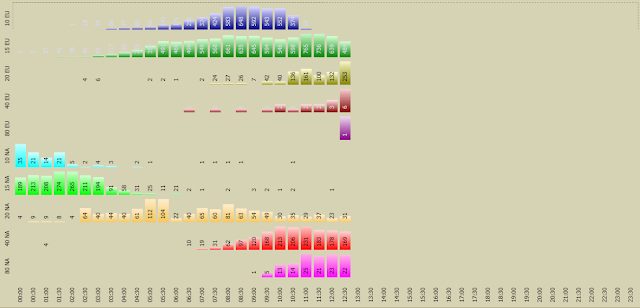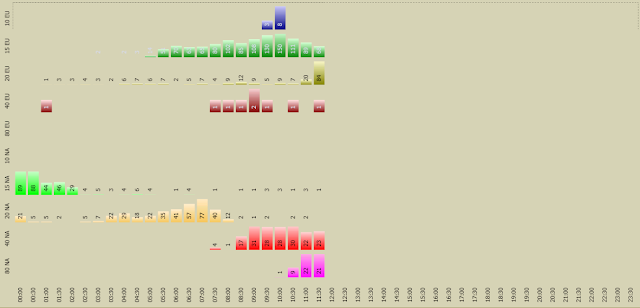Kudos to Rick ZL2HAM, who has developed a truly fantastic tool called
ViewProp, with which you can visualise RBN data in various ways (as well as traditional DX spots).
From a contester's perspective, I am very interested in
the time course of the openings from JA to Europe and North America. Knowing and preparing for them are most crucial in contest strategy.
ViewProp can now load raw RBN spot data for a day of interest and do exactly what I need. I'll show you some examples here.
Click on images below to enlarge.
Each image has ten rows. The upper five are for EU (10-15-20-40-80 meters) and the lower five for NA.
2013 All Asian CW
(2013/6/15) SFI=110, SSN=101, A=3, K=1
(2013/6/16) SFI=115, SSN=104, A=3, K=1
- This contest enjoyed typical summer openings through the night on high bands, often seen at cycle peaks.
- Fifteen was open nearly 24 hours to Europe!
- Although SSN hit 200 a few weeks ago, it unfortunately came down to around 100 now so openings on ten were marginal.
- Twenty was also excellent especially for EU.
- You can see very short openings on forty (and eighty) toward EU.
- High band openings for NA in local mornings (around 0z) are surprisingly poor. This could be due to lack of participation from eastern NA being far flung from Asia.
.
2013 CQ WPX CW
(2013/5/25) SFI=121, SSN=107, A=37, K=4
(2013/5/26) SFI=120, SSN=92, A=18, K=4

- This contest suffered greatly from a coincidental geomagnetic storm.
- Compared to AA CW above, EU openings on 15 and 20 were significantly poor and 10 and 15 for NA were disastrous. (Openings in local Sunday morning were almost non-existent.)
OK, now let's see
the big one in autumn.
2012 CQ WW CW
(2012/11/24) SFI=118, SSN=87, A=15, K=4
(2012/11/25) SFI=121, SSN=64, A=4, K=0
- Compared to AA CW (in summer) above, this contest shows typical winter condition.
- Ten and 15 openings are much shorter, while 40 and 80 much longer.
- The initial running of day one for NA was a struggle, perhaps due to geomagnetic turbulence.
- On the 2nd day local morning high band openings for NA were slightly improved.
I now realise CQ WW CW to be really a WINTER contest. Perhaps we need more focus on low bands (especially 40).
Now let's look at the year before.
2011 CQ WW CW
(2011/11/26) SFI=132, SSN=117, A=3, K=1
(2011/11/27) SFI=135, SSN=123, A=6, K=1
- Geomagnetic activity quieter and solar indices higher than 2012 so 'shapes' are more normal.
- Even so, 10m openings to EU were very short in duration.

















